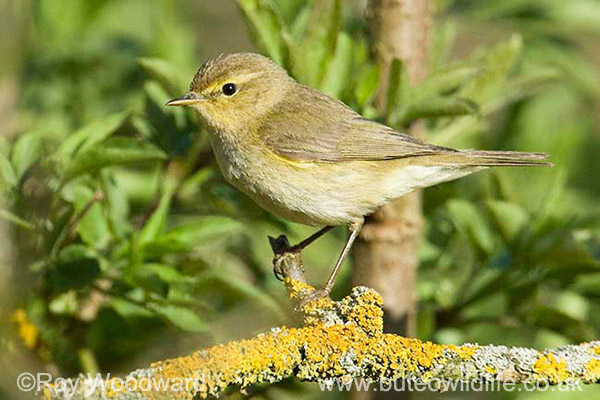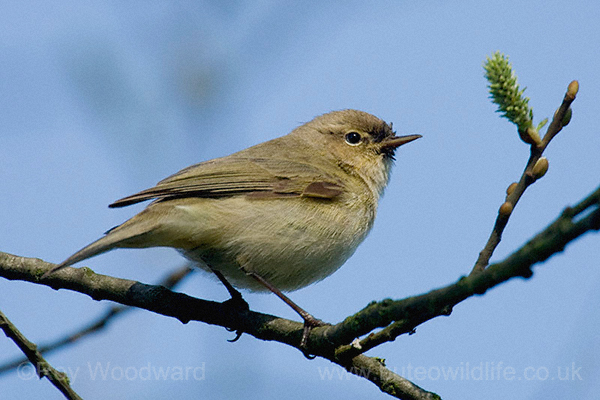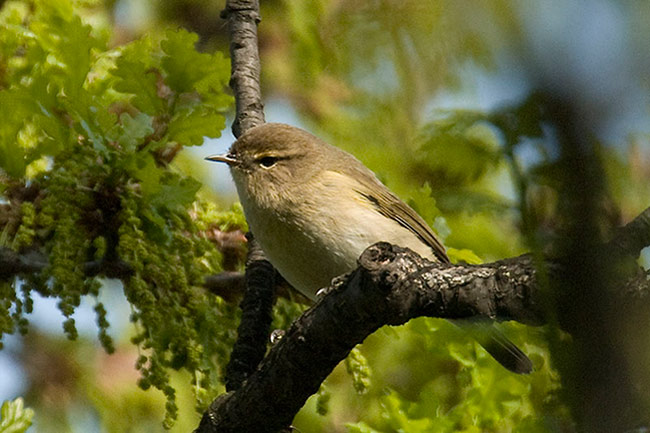Many bird species can be difficult to identify, particularly when you are new to birdwatching, but there are some that tend to be more problematic than others, and two widespread and relatively common UK species, which can take birdwatchers time to get to grips with, are Chiffchaff and Willow Warbler.
At one time Chiffchaff and Willow Warbler were typically treated as just one species, along with the larger and brighter Wood Warbler. It is Gilbert White, an 18th century naturalist, who spent his life in Selbourne, Hampshire, who is generally credited with being the first to show that there was more than one different species.
In a letter to Thomas Pennant, dated August 17th 1768, he writes:
“I have now, past dispute, made out three distinct species of the willow-wrens (motacillae trochili) which constantly and invariably use distinct notes” *
Later in the letter he goes on to describe the song and plumage of the most distinct of the three, the “largest willow-wren” (Wood Warbler), in some detail. Little mention is made of the differences between the “smallest willow-wren” (Chiffchaff), and the “middle willow-wren” (Willow warbler) in this letter, except the slight difference in size, and the fact that the smallest willow-wren had dark legs, in contrast to the other two species’ pale legs.
(*From “A Natural History of Selbourne”, a published collection of Gilbert Whites letters to other naturalists of his time.)
The difference in song remains the easiest way to separate Chiffchaff and Willow Warbler in particular – but birds aren’t always singing when you see them!
Thankfully, there have been nearly 250 years of observations since Gilbert Whites time, and other identification features have been worked out!
'Hovering' over the photos with your mouse should reveal annotations pointing to the relevant identification features in each case.
With thanks given to Stuart Fisher for giving permission for the use of his recordings on xeno-canto.org (click on the triangular 'play button' to listen to each recording).
________________________________________________________________________
Wood Warbler (Phylloscopus sibilatrix).
When seen well this is a distinctive species, with a very different appearance and structure from Chiffchaff and Willow Warbler, they are also slightly larger, although this isn’t always apparent in the field. Although they are less likely to be confused that Chiffchaff and Willow Warbler, for completeness it is worth mention this species first.
The least widespread of the three “willow-wrens”, Wood Warblers no longer breed in most areas in south-east and central England. In the UK it now has a distinctly western distribution bias, and typically favours mature woodland when breeding (although migrants can sometimes be found elsewhere).
Wood Warblers reach the UK in mid-late April each spring, and have left by mid September, with the species wintering south of the Sahara in a band across central Africa.
The main identification features are as follows:
- Long wings and short tail, giving a different shape to Chiffchaff and Willow Warbler.
- The wing feathers have broad greenish edges.
- Upperparts tend to have more of a green tone that those of Chiffchaffs and most Willow Warblers.
- Broad yellow supercilium, cheeks, and throat which contrast with the white breast and belly. Beware of some Chiffchaffs and Willow Warblers which can have brightly coloured throats.
- Legs tend to be pinkish, but can be browner.
Wood Warblers typical song is a trill that can be likened to a spinning coin coming to rest on a hard surface (as in the above recording). They can also be heard giving a loud, clear “Chee- chee- chee- chee”.
________________________________________________________________________
Chiffchaff and Willow Warbler are far more similar to each other in appearance, and to make matters worse most of the useful features can vary between individuals!
Both are small, slim, green-brown warblers, with yellowish or off white underparts.
For identification in the field, the best feature to look for is the primary projection – the length of the exposed primary feathers visible on the folded wing, as compared to the length of the exposed tertial feathers. It is the length of the exposed part of the primaries that is important, not how long the wings look (although a longer primary projection can give the impression of longer wings).
Song is also diagnostic when heard, and with experience calls can also be differentiated.
Other features can be used as a guide, but are not diagnostic.
Willow Warbler (Phylloscopus trochilus).
Widespread and common throughout the UK, perhaps with a tendency to be more numerous towards the north. Open scrub, heathland, and similar habitats, with scattered taller trees tends to be the favoured, although they can also be found breeding in hedgerows and woodland edge habitats.
The first migrant Willow Warblers arrive in the south in late March, with a more widespread arrival from early to mid April. Most have left for the southern half of Africa before the end of September, although a few may be seen in October.
Adult Willow Warbler.
1st winter Willow Warbler.
The typical appearance is of a greenish or brownish, warbler with clean, largely whitish underparts. The yellow on the underparts is usually restricted to the head and upper breast, but can be especially prominent in juveniles and 1st winters, in which the entire underparts can be a uniform, and sometimes quite bright, yellow colour.
Whenever possible it is useful to assess the 'primary projection' on individuals that aren't heard, the other features listed can also be useful but will not be seen on all individuals.
- Primary projection of 75-100% of the length of the exposed tertials.
- Usually a strong face pattern, with a long supercilium, and strong dark eyestripe.
- Cheeks tend to be flecked with yellow, which makes them look pale centered.
- A pale eye-ring is present but rarely stands out against the pale centred cheeks.
- Underparts usually look ‘clean’ without the indistinct brown wash, or patches at the side of the breast that is often seen on Chiffchaffs.
- Legs are typically a pale brown or flesh colour – they can be dark in a small percentage of individuals though, and even if they are not dark lighting can make them appear darker than they are.
- Pale areas on the lower mandible are often more extensive, and more sharply defined than on Chiffchaffs.
Typical cascading Willow Warbler song (left-hand recording), and a more 'hesitant' variant.
Typical calls are a clear “Ho-eet”, with the two notes usually obviously differentiated.
A few greyer/whiter individuals from the populations that breed in Scandinavia (Phylloscopus trochilus acredula) may be seen on passage.
________________________________________________________________________
Chiffchaff (Phylloscopus collybita).
A Common and widespread breeding species throughout the southern parts of the UK, becoming more local in northern parts of Scotland, which favours open areas with some mature trees, such as woodland edges.
Since the 1950s and 60s, Chiffchaffs have become increasingly more numerous during the winter, predominantly in southern counties, but with a few wintering as far north as parts of Scotland. It seems that many, but perhaps not all, of the wintering birds originate from different populations from the breeding birds, which arrive in mid March after spending the winter in Iberia or northern parts of Africa, and head south-west again in the autumn. At least a percentage of those that are here during the winter tend to show characteristics of northern and eastern subspecies – though because individuals of all subspecies can be so variable it is often difficult to assign them to a specific subspecies in the field with any certainty.
Chiffchaffs often have a tendency to look ‘duller’, and ‘dingier’ than most Willow Warblers, with ‘dirtier’ looking underparts - although they can be as bright as the brightest Willow Warblers. They also have a tendency to continually flick their tail downwards while moving around (Willow Warblers may also do this but it tends to be less persistent).
- Primary projection of no more than 50-60% of the exposed tertial length.
- The supercilium can be distinct, but it is often weak behind the eye, and there is usually no obvious dark line through the eye.
- The cheeks tend to be plain and dark centred.
- A pale eye-ring is present, and the lower half has a tendency to stand out strongly against the usually dark cheeks.
- There are often indistinct dark markings on the breast sides, and sometimes a brown wash forming an indistinct dark band across the breast or on the flanks.
- Legs are typically dark brown or black, but can be, or appear, pale in some individuals, especially those seen in bright sunlight.
- The bill tends to be dark, but may have pale areas on the lower mandible, which are often relatively diffuse, without sharp demarcation.
The song of the races that breed in the UK (Phylloscopus collybita collybita), and much of Scandinavia (P. c. abietinus), is one of the easiest to identify because Chiffchaffs are one of the bird species that sing their name – though sometimes even they seem to get a little confused! ('normal' song, and a variant version are linked above).
The calls are similar to those of Willow Warbler, but tend to be a more slurred, “weet” without the ‘dysyllabic’ sound of Willow Warbler, and with an upward inflection at the end. Calls can be heard in the first of the two song recordings (above), but two different versions of calls are also given (the "sweoo" type of calls heard in the right-hand recording seem to mainly be heard during the autumn).
Other subspecies of Chiffchaff are regularly seen in the UK, and these are briefly covered below:
Scandinavian Chiffchaff (Phylloscopus collybita abietinus).
Regular as a passage migrant and winter visitor to the UK, mainly between September and April, but not always separable from the P. c. collybita subspecies that breeds in the British Isles.
- Typically greyer, or more olive toned, above and whiter below than most British birds, with very limited yellow on the underparts and in the supercilium.
- Usually a more distinct supercilium, which extends further beyond the eye.
- Often a faint greenish wash on the upperparts, and often greenish edges to the flight feathers.
- On average tend to have a marginally longer primary projection than P. c. collybita.
Song and calls are similar to those of P. c. collybita.
Siberian Chiffchaff (Phylloscopus collybita tristis).
A rare late autumn visitor from the east with some individuals staying for the winter. Occasional spring records may involve birds that have wintered elsewhere in Britain or western Europe.
- Grey-brown and buff toned. Typically without any trace of yellow anywhere except at the bend of the wing, or any greenish tones, except at most on the rump and uppertail coverts, and the edges of the flight feathers.
- Bare parts (bill and legs) are usually black.
- Often a narrow pale wing bar on the greater coverts.
It can be difficult to conclusively identify tristis without reference to the song or calls, which are both distinctive:
The song of P. c. tristis is a jumble of notes very different from the ‘normal’ Chiffchaffs that we see in the UK and with a quality that is superficially reminiscent of Willow Warbler. Song typical of tristis can be heard in the first part of the above recording, which then switches to typical collybita/abietinus song.
Calls are a higher pitched “eeep” than those of other subspecies, lacking the upward inflection at the end.
________________________________________________________________________
So what are these three then? (hover over the image with your mouse pointer to reveal the answers, and the features that help with the identifications).









.jpg)
.jpg)
.jpg)


























